“The Morphological Laboratory”, 1883 – ca. 1884
John Ernest Ady, 1857 – 1918
Heinrich Hensoldt, 1856 – ca. 1918
by Brian Stevenson and Steve Gill
last updated February, 2014
The
“Morphological Laboratory” was a scientific sales partnership formed in 1883 by
Heinrich Hensoldt and John Ernest Ady. Hensoldt, a son of microscope
manufacturer Moritz Hensoldt of Wetzlar, was an accomplished preparer of
thin-sectioned minerals for the microscope/polariscope. Ady was experienced in
several aspects of microscopy, and with scientific writing and drawing
illustrations. Ady was at the time an editor of Studies in Microscopical Science, along with Arthur C. Cole. A short-lived partnership was also in effect with mounter Arthur Doherty. It is reasonably certain that some of the mineral slides sold under the label of The Morphological Laboratory were made by Hensoldt, while others were likely produced by Ady and Doherty. Other makers, such as Cole, may also have provided slides to the company. Further details of the life of Heinrich Hensoldt and A.J. Doherty can be read elsewhere on this site. The life of J.E. Ady has been described in publications in the Quekett Journal of Microscopy, and will also be forthcoming on this site.
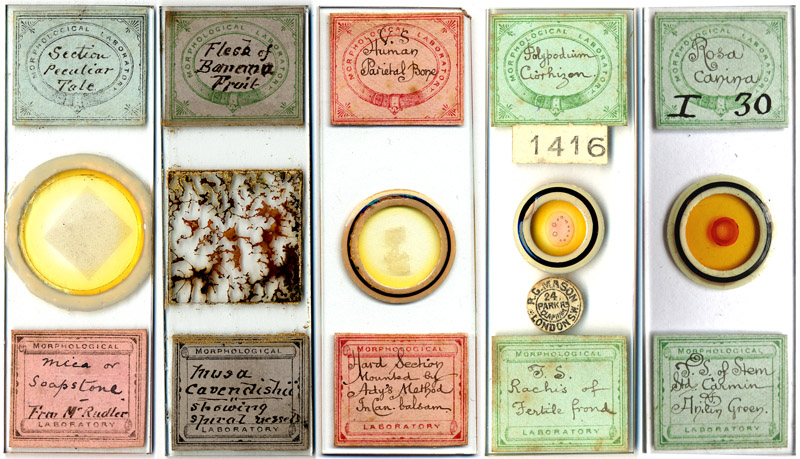
Figure 1.
Examples of microscope slides sold by The
Morphological Laboratory. Hensoldt produced lapidary slides for the
Morphological Laboratory until he left England ca. 1884, so he may have made
the leftmost slide of talc/mica/soapstone. “Mr. Rudler” was probably geologist
William F. Rudler. The other illustrated slides were probably made by Ady,
Doherty or contract mounters. There is no evidence to connect R.G. Mason with
The Morphological Laboratory, so Mason’s trade label on the
next-to-the-right-end slide is probably from a re-sale. The center slide, a
section of human parietal bone, was advertised in February, 1884 for 10 pence
(see Figure 4).
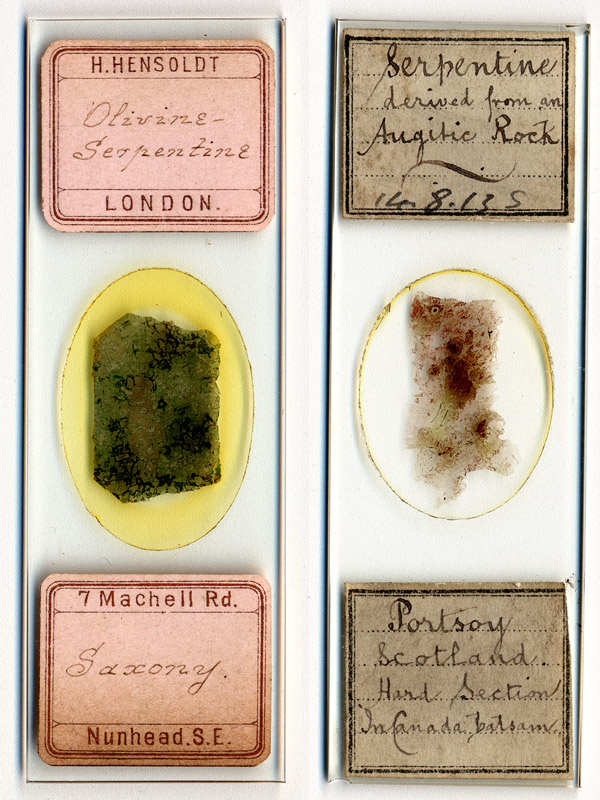
Figure 2.
Left, a thin-sectioned mineral microscope slide
prepared by Heinrich Hensoldt. Right, the handwriting on the labels of this
mineral thin-section slide is the same as on the three right-most slides of
Figure 1 (above). This may be Ernest Ady’s handwriting.
Ady
and Hensoldt planned, among other things plans, to produce a collectable work
of “etched diagrams” and “specimens made by Hr. Hensoldt”.
Significantly, this collection of drawings and microscope slides would be made
available by “subscription, payable in
advance.” In other words, Ady and Hensoldt collected their money in
advance, with the promise that they would deliver at a later date.
The
December, 1883, Hardwicke’s
Science-Gossip included an editor’s report on Hensoldt and Ady’s new
business. “A New Morphological
Institution.- We understand that a Morphological Laboratory is about to be
instituted in London by Mr. John Ernest Ady, whom most of our readers will
remember as the author of Vol. I. of the ‘Studies in Microscopical Science,’
nominally edited by Mr. Arthur C. Cole, the well-known object mounter, who
prepared the slides in illustration of that work. At present the laboratory is
limited to the production of microscopical preparations, and especially of rock
and mineral sections, in which latter Mr. Ady has the co-operation of perhaps
the most efficient preparer in Great Britain, Mr. H. Hensoldt. Messrs. Ady and
Hensoldt propose to issue a series of rock sections, with explanatory etched
diagrams and letterpress descriptions, early next January. No fewer than
twenty-four exquisitely prepared specimens, accompanied with copious notes and
sketches, and issued fortnightly, will be furnished to subscribers for a sum of
a guinea and a half. As the supply of the work can be but limited to about one
hundred copies, we strongly recommend our readers to make an early application.
This limitation we hear is compulsory, because the labour requisite for the
production of a greater number of specimens cannot be secured. The laboratory
will include an educational, and an exchange and mart department. For further
information, we refer our readers to 7, Machell Road, Nunhead, London, S.E.”
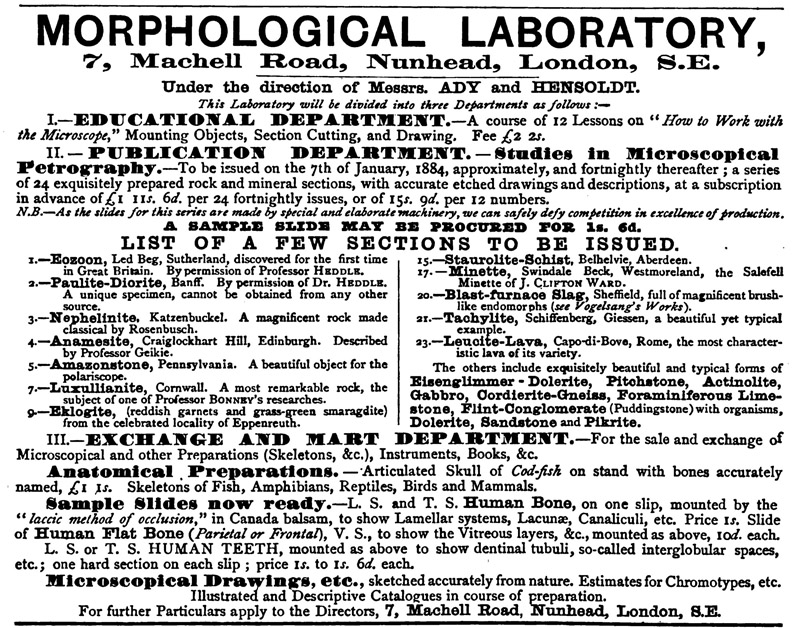
Figure 3.
The January, 1884 Hardwicke’s Science-Gossip
advertisement from Hensoldt and Ady, announcing their new Morphological
Laboratory. The given address, 7 Machell Road, was Hensoldt’s home.
The
January, 1884, issue of Hardwicke’s
Science-Gossip reported, “Microscopy
Sample Slides.- We have received two of the slides prepared by Messrs. Ady
& Hensoldt, as advertised in our columns. One of them is a double object,
containing both a longitudinal and a transverse section of the compact tissue
of the middle of shaft of the human humerus, mounted in gum and Canada balsam;
and the other a section of the Eozoonal white Serpentine, recently discovered
by Dr. Heddle in Sutherlandshire. These specimens approach the best style of mounting
we have yet seen, and if the new Morphological Laboratory continues to send
forth slides of this character it cannot fail soon to command general attention”.
The human bone slide was advertised as a “sample
slide” in the partnership’s January advertisement (Figure 3). The “Eozoonal white Serpentine” was also to
be the first specimen provided to subscribers of Microscopical Petrography (see below).
The
journal Nature was also supportive of
the project, writing on January 24, that "Studies in Micrographic
Petrography. (Ady and Hensoldt, 7,
Machell Road, Nunhead, S.E.) The growing interest taken in this country in the
study of petrography is well shown by the rapidly increasing facilities offered
for the prosecution of this branch of science. The most recent of these has
just appeared under the foregoing title. It is to consist of the issue of two
dozen microscopic slides of characteristic minerals and rocks prepared by Mr.
Hensoldt of Wetzlar, with illustrative drawings and descriptive text by Mr.
J.E. Ady, who is already favourably known for his microscopic preparations of
British rocks. The first number of the ‘Studies’ is devoted to ‘Eozoon, Led Beg, Sutherland’. It
contains two lithographic plates illustrative of the so-called eozoonal
structure of a limestone in the north of Scotland, and four pages of
descriptive text. The author gives a brief reference to the literature of the
subject, and an account of the microscopic structure of some portions of the
limestone in question, which he regards as akin to that of the Canadian Eozoon, but as being of inorganic
origin. We are afraid his sketch is too slight to have much weight in the
controversy regarding Eozoon. His
effort to extend the opportunities of petrographical investigation, however,
and to popularise this fascinating but difficult branch of geology is
praiseworthy, and we hope that his ‘Studies’ may meet with such success as may
induce him to continue them”.
Hardwicke’s Science-Gossip noted, "Petrographical Studies.- We have received No. 1 of Messrs. Ady & Hensoldt's new publication bearing the above
title. It deals with the specimen of Calciferous Serpentine sent out as a
slide, to which reference was made in our last number, commonly called
eozoonal. A brief, but exceedingly clear abstract is given of the opinions of
Carpenter and others as to the organic character of Eozoon, on the one hand,
and of Mobius on the other. The Sutherlandshire Eozoon lends considerable
evidence to the mineralogical theory of Professors King, Rowney, and Mobius.
The sketches accompanying the part are very carefully drawn and executed”
The
February issue also included two advertisements from The Morphological
Laboratory, providing more details on the subscription series and an apparently
novel type of microscopical cabinet (Figure 4). The advertisement listed
several prominent names who had already paid their subscriptions. Due to high
levels of interest in the series, Ady and Hensoldt increases the number of
subscriptions from 100 to 150.
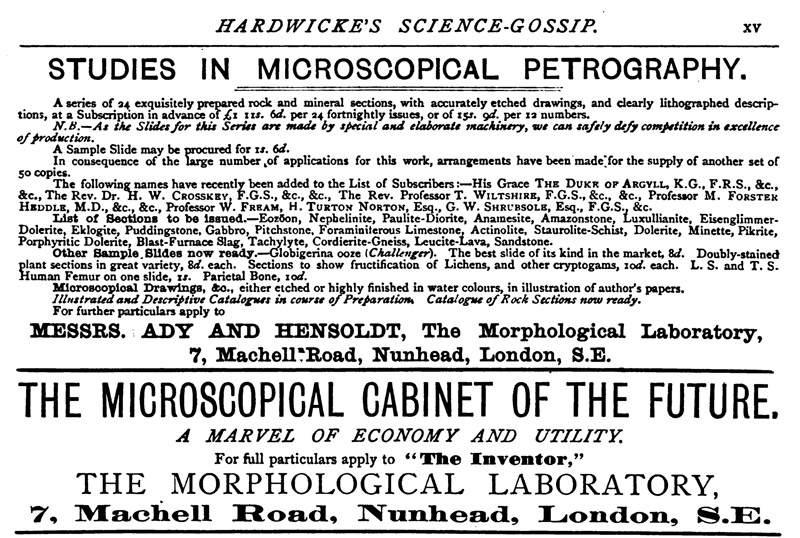
Figure 4.
Advertisements from Hensoldt and Ady’s business,
February, 1884 issue of Hardwicke’s Science-Gossip. The structure of Hensoldt’s
‘Cabinet of the Future’ is not known.
The February advertisement mentioned that The Morphological Laboratory would also provide “double-stained plant sections in great
variety” and “sections to show
fructification of Lichens, and other cryptograms”. At this same time, Ady
formed a partnership with Manchester slide-maker Arthur Doherty, and, beginning
in March, began a series similar to the petrographical series. Doherty was
renowned for his double-stained botanical section slides. One of the first
specimens he provided to the Ady and Doherty series was of the lichen Physcia
stellaris. Thus, it is likely that some
botanical slides offered by Ady and Hensoldt were produced by Doherty.
The
progress, and rapid demise, of the Studies in
Microscopical Petrography can be followed in subsequent issues of Hardwicke’s Science-Gossip
March,
1884: “Petrographical Studies.- We have
received two exquisitely prepared slides illustrative of this series, now being
issued by Messrs. Ady & Hensoldt. One is a section of Nephelinite, from the
Odenwald, perhaps the most remarkable of all volcanic rocks, for its beautiful
appearance under the polariscope. The other is a section of Amazon stone (a
green feldspar) from America. Both slides are accompanied by terse, but
accurately written, descriptions. A new and valuable feature in this work is
the series of hand-tinted plates illustrating the essays, which enable a
student easily to verify the various mineral constituents of each specimen”.
April,
1884: "Petrographical Studies, by Messrs. J.E. Ady and H. Hensoldt. The
last two parts of this valuable work, from the exquisite neatness of the
lithographed text, and the carefulness with which the plates have been
coloured, indicate the intention of the authors to give the world a really good
and useful production. The objects figured and described are ‘Paulite-Diorite’,
from Banff, Scotland, magnified twenty diameters; and ‘Pikrite’, from Inchholm,
Firth of Forth, magnified thirty diameters. The slides sent out with these
papers are, of course, specimens of the rocks themselves, and they are cut and
mounted in Mr. Hensoldt's best style of workmanship. Mr. Ady's ‘Popular Studies
in Comparative Histology’, in which he is assisted by Mr. A.J. Doherty, of the
Victoria University, Manchester, commenced on March 10th.”
May, 1884: “Petrological Studies.- The last two slides
sent out from Messrs. Ady & Hensoldt's
morphological laboratory fully sustain the high character which these
petrological studies have already earned among geologists and mineralogists.
The first is a specimen of Pitchstone, from the Isle of Arran, and is
accompanied by a gracefully-written and very interesting essay, with a coloured
plate showing the composition of the mineral as it appears when x 150, and a
detailed explanation of each substance. The second slide is a
beautifully-prepared section of Anamesite, from Craiglockhart, Scotland. The
physiological preparations have been commenced, one showing a section of the
common lichen (Physcia stellaris) through
a mature apothecium, plainly reveals both brown spores and green conidia. It is
a very striking object, and of great value to the botanical student.”
July, 1884: “Mr. J.E. Ady writes to say that owing to certain differences betwixt himself and his colleague, Mr. Hensoldt (which we cannot enter into here), he begs the indulgence of the subscribers until suitable arrangements can be made for continuing the Petrological Studies.”
August, 1884: “Mr. A.J. Doherty requests us to inform our readers
that he has withdrawn from his connection with Mr. J.E. Ady, and that none of
the slides accompanying the ‘Popular Studies in Comparative Histology’, with
the exception of the sections of Physcia stellaris and Rosa canina, will be prepared by him”.
and
Petrological Studies.- Mr. J.D. (sic) Ady has issued another part of these Studies, dealing with the Dolorite of Whitwick,
the Olivine-Serpentine of Saxony, and the Luxulyanite of Cornwall. It is
illustrated by three admirably drawn plates, and the text is turned out with
the usual neatness and finish.”
The magazine made no specific mention of the Petrological Series after that. However, the February, 1885, Hardwicke’s Science-Gossip noted that Ady was providing what may have been substitutes for the mineral slides, “We have received from Mr. J.E. Ady, an additional issue of his able papers, entitled ‘Deep Sea Soundings,’ illustrated. Mr. Ady also offers what he calls ‘Optional Slides’ to his subscribers.” If the Hardwicke’s Science-Gossip reports are a complete description, then
Hensoldt provided only 7 of his 24 promised specimens. Whether Ady completely
fulfilled the subscriptions is not clear, nor is it known whom he found to
prepare the additional slides described in August, 1884. With over 100,
possibly as many as 150, subscribers who pre-paid nearly £2 each, there may
well have been a considerable number of angry customers in England.
Hensoldt
had fled the country. He resurfaced in Cedar, Texas, U.S.A., a small, rural
town that was about as far as possible one could move from London. Cedar had a
large population of recent German immigrants, and Hensoldt taught their school.
Through the next three decades, Hensoldt lived a remarkable (and shady) life as
an instructor at Columbia University, lecturer on the Indian subcontinent,
quack physician, and bigamist many times over, eventually disappearing from
records in 1917 while the FBI was investigating him for espionage.
Ady involved himself with several further microscopy and geology projects. During the 1890s, he changed his professional name to Ernest Howard Adye. That was probably to distance himself from his elder brother, who became notorious for providing illegal abortions and causing at least one woman’s death.
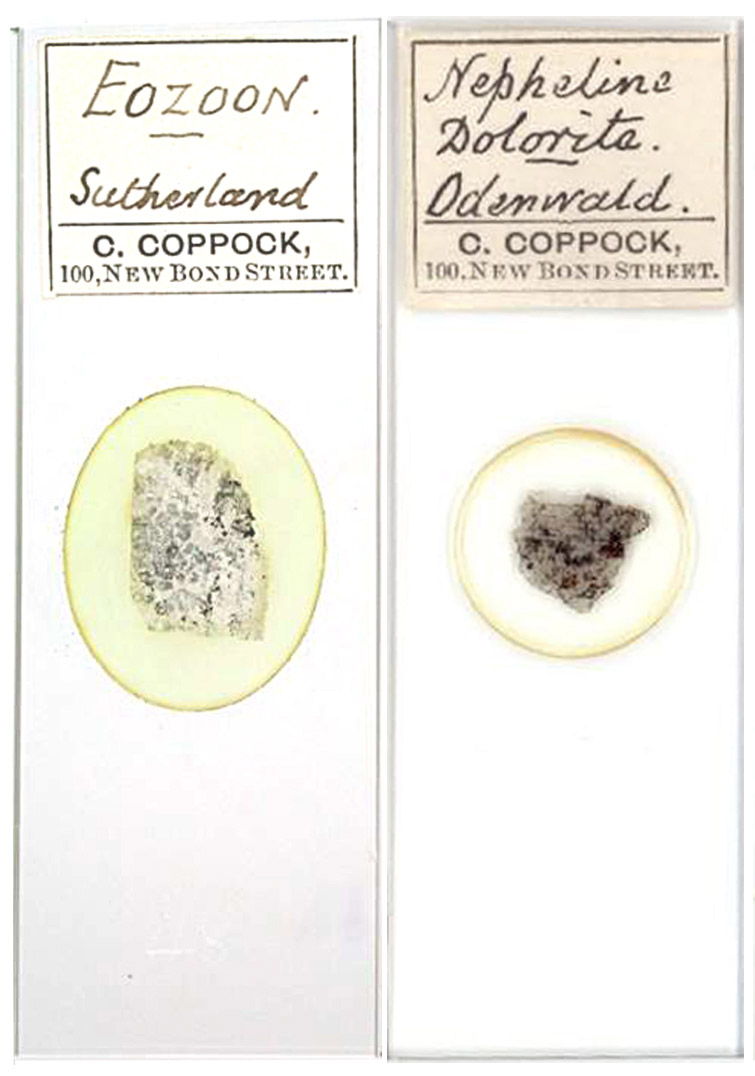
Figure 5.
Charles Coppock was a managing
partner of R. & J. Beck, resigning from that company in early 1883 to form
his own optical business. He sold outsourced microscope slides under his own
name. These two slides of thin-sectioned rocks bear strong similarities to
those produced by Hensoldt. The specimens, Eoozoan from Sutherland and
Nepheline Dolorite from Odenwald, were also sold as part of Hensoldt and Ady’s ‘Studies in Microscopical Petrography’.
Acknowledgements
We
thank Brian Davidson for pointing out the similarities between mineral slides
produced by Hensoldt and those sold by Charles Coppock; and Howard Lynk and
Peter Paisley for helpful discussions.
Resources
Bracegirdle, Brian (1998) Microscopical Mounts and Mounters,
Quekett Microscopical Club, London, pages 51 and 192, plate 25 slide J, and plate 44 slide N
Gill, Steve (2008) The Adye enigma, Quekett Journal of Microscopy, Vol. 40, pages 685-694.
Gill, Steve (2009) The Ady(e) enigma - resolved, Quekett Journal of Microscopy, Vol. 41, pages 121-131.
Hardwicke’s Science-Gossip (1883) A new morphological institution, Vol. 19, pages 276-277.
Hardwicke’s Science-Gossip (1884) Advertisements from the Morphological Laboratory, and editors’ notes of
slides produced by the Morphological Laboratory, Vol. 20, January issue p. vii,
February issue page xv, and pages 18, 41-42, 67, 90, 114-115, 162, 185.
Hardwicke’s Science-Gossip (1885) Editors’ note of slides supplied by J.E. Ady, Vol. 21, page 63./p>
Hunt, Robert and FrederickWilliam Rudler (1878) Talc, in Ure’s Dictionary of Arts, Manufactures, and Mines, Seventh edition, Longmans,Green and Co., London, page 967.
Nature (1884) Studies in micrographic petrography, Vol. 29, page 283.
Poerzag, Karsten (2001) Hensoldt: Geschichte Eines Optischen Werkes
in Wetzlar, Porezag, Wetzlar.
Stevenson, Brian, and Steve Gill (2013) The many lives of Heinrich Hensoldt (1856 – circa 1918), Moritz Hensoldt’s errant son, Quekett Journal of
Microscopy, Vol. 42, pages 3-17.




